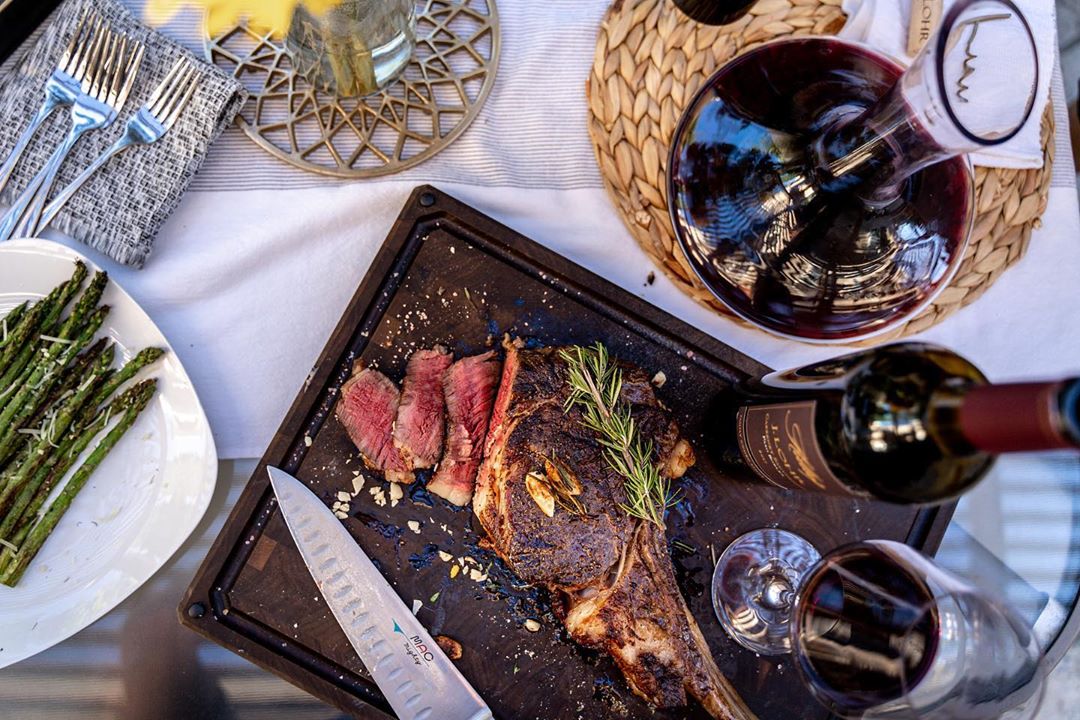
Cutting Board Oil vs. Conditioner: Which is Best For Board Care?
We’ve all been there. You’re prepping dinner for the hundredth time on the plastic cutting board you found on a random end cap, when you realize the time has come to upgrade your kitchen. After all, you’ve been looking for the chance to put the ‘treat yo' self’ mantra into action, so what better way than to invest in a quality wood cutting board?
As with all investment pieces, you want to make sure that the handsome little devil you just brought home will stay handsome and, more importantly, useful for as long as possible. There are many products out there, but before we dig into which is best and what to look for, it’s helpful to know why a wood cutting board needs to be maintained in the first place.
TL;DR: Proper Board Care Tips
-
Wood needs hydration just like your skin — or it will dry out and crack.
-
Best products: Look for food-grade mineral oil (deep hydration) and beeswax (surface protection).
-
Hybrid products that combine both oil and wax are super convenient.
- Oiling schedule: Every 2–3 weeks — especially for maple and end-grain boards, which are "thirstier."
- Avoid using: Olive oil, vegetable oil, canola oil, and sesame oil — they can go rancid and make your board smell bad.
Understanding the Importance of Cutting Board Care
As with any organic substance, wood is susceptible to the elements. For example, when you’re in a cold or dry place, your skin can dry out and crack if it's not properly moisturized. Also, depending on what type of skin you have, you might need to apply more often or add another product to keep your skin in tip-top shape. Much in the same way, wood fibers can dry out and crack if they don’t stay hydrated, and some species may need more TLC than others. Let’s take a look!
The Best Products for Wood Cutting Board Care
Although products out there may go by many aliases, such as seasoning, butter, cream, or conditioner, there are two staple ingredients to look for when selecting a product: oil and wax.
Food-Grade Mineral Oil (Cutting Board Oil)
This is the main ingredient in most products for board care, and with good reason. Food-grade mineral oil is crucial because it soaks deep into the wood fibers, keeping them hydrated. It’s also colorless, odorless, and tasteless.
Pro Tip: Be careful of product names–cutting board oil is not always the same as mineral oil, depending on the brand.
Fractionated Coconut Oil (Cutting Board Oil)
Fractionated coconut oil is a type of coconut oil that has been processed to remove specific fatty acids, mainly those that cause the oil to solidify at cooler temperatures. As a result, it stays liquid at room temperature and has a longer shelf life than regular coconut oil.
Beeswax and Carnuba Wax (Cutting Board Conditioner)
This is the most common type of wax used in board care products. Beeswax is vital because it conditions and creates a thin, natural barrier on the surface of the board, which keeps out external moisture, such as water, juices, and food oils.
Look for products that also include caranuba wax, which is often more glossy compared to other natural waxes. When applied after oil, it’s an excellent conditioner for your wood cutting board because it creates a stronger and longer-lasting protective layer.
Pro Tip: Use wax in addition to oils, not as a substitute for them. Wax simply can’t soak into the wood and moisturize it like oil can.
How Often Should I Oil My Wood Cutting Board?
Ideally, you should oil your board every three weeks to keep it looking great and functioning properly. Here are the main steps to follow:
-
Before oiling your board, make sure it’s clean and completely dry.
-
Apply food-grade mineral oil directly to the board, using a dry dish towel to spread the oil.
-
Next, apply a layer of beeswax to condition and reinforce a natural barrier.
Pro Tip: Instead of using two separate products, we recommend a hybrid product that combines food-grade mineral oil and beeswax.
Check out our board care guide.
Some Boards Are Thirstier Than Others
Not all cutting boards have the same properties. If you have a maple board, or an end-grain constructed board, we recommend oiling it every two to three weeks.
Shop end grain cutting boards.
How to Spot Clean Your Wood Cutting Board
White Vinegar (Best for Deodorizing and Light Sanitizing)
Vinegar is a natural disinfectant and deodorizer, making it ideal for neutralizing smells like garlic or onion.
How to Use:
-
Pour or spray white vinegar directly onto the spot.
-
Let it sit for a few minutes.
-
Wipe off with a damp cloth and dry immediately.
Baking Soda Paste (Best for Stubborn Stains)
Baking soda is a mild abrasive, great for lifting deeper stains without scratching the wood.
How to Use:
-
Mix baking soda with a little water to form a paste.
-
Rub the paste gently onto the stain using a soft cloth or sponge.
-
Wipe clean with a damp cloth, then dry immediately.
Lemon and Salt (Best for Deep Stains and Odors)
The salt acts as a gentle scrubber and the lemon’s acidity helps break down tough stains and neutralize odors.
How to Use:
-
Sprinkle coarse salt (like kosher salt) over the stained area.
-
Cut a lemon in half and rub it across the salt and stain.
-
Let it sit for 5 minutes, then wipe clean with a damp cloth and dry.
Oils to Avoid Using on Your Wood Cutting Board
Not all products are made the same. Let’s debunk some cooking oils that you should avoid using to treat your board with:
-
Olive oil
-
Vegetable oil
-
Canola oil
-
Sesame oil
These types of oils are high in fat and, once oxidized, can become rancid, transferring an unpleasant smell into the wood.
Note: Of course, you can still use these oils on your cutting board when cooking, but we don’t recommend using them to hydrate your board.
Frequently Asked Questions
How often should I oil my wood cutting board?
Oil your wood cutting board every two to three weeks, or whenever it looks dry, to keep it hydrated and protected.
What’s the best oil for cutting boards?
Food-grade mineral oil is the best choice because it’s colorless, odorless, tasteless, and won’t go rancid over time.
Can you use olive oil to treat a cutting board?
No, olive oil can go rancid and leave your cutting board with an unpleasant smell and sticky residue.
How do you remove stains from a wood cutting board?
Use a baking soda paste, white vinegar, or lemon and salt to gently lift stains without damaging the wood.

